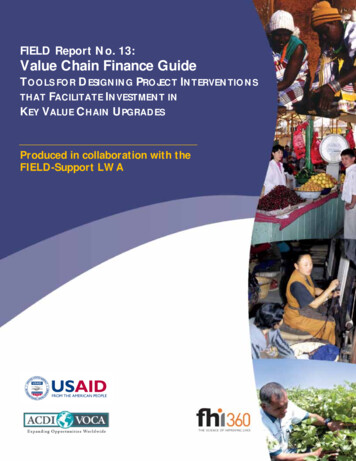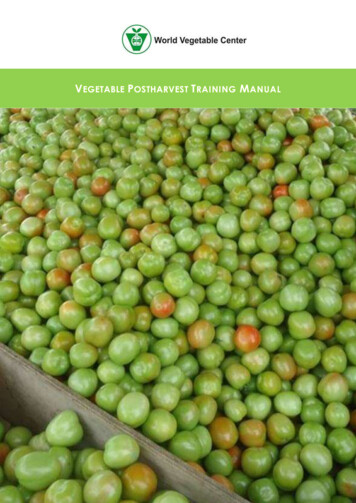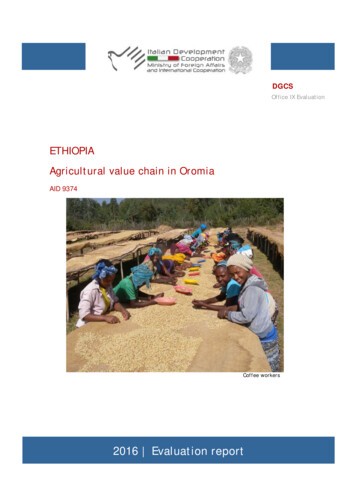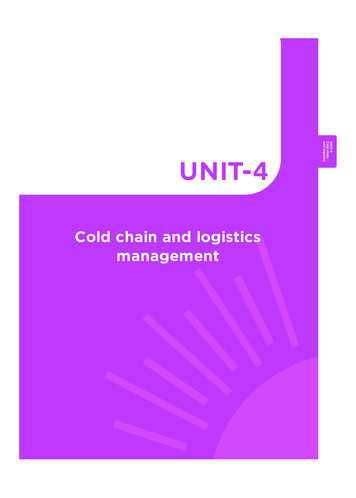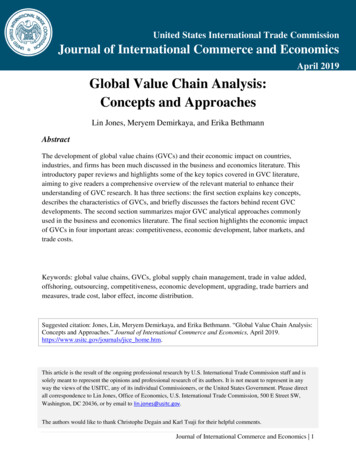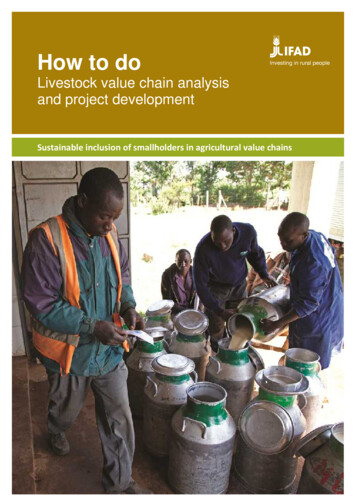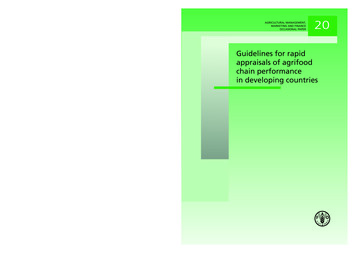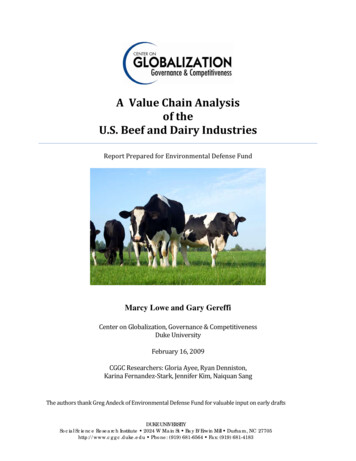
Transcription
A Value Chain Analysisof theU.S. Beef and Dairy IndustriesReport Prepared for Environmental Defense FundMarcy Lowe and Gary GereffiCenter on Globalization, Governance & CompetitivenessDuke UniversityFebruary 16, 2009CGGC Researchers: Gloria Ayee, Ryan Denniston,Karina Fernandez-Stark, Jennifer Kim, Naiquan SangThe authors thank Greg Andeck of Environmental Defense Fund for valuable input on early draftsDUKE UNIVERSITYSocial Science Research Institute 2024 W Main St Bay B/Erwin Mill Durham, NC 27705http://www.cggc.duke.edu Phone: (919) 681-6564 Fax: (919) 681-4183
Table of ContentsI. Introduction. 4III. U.S. Beef Industry . 9A. Beef Industry: Overview . 10B. Beef Industry: Value Chain. 14C. Beef Industry: Economic Actors and Leverage . 17Key Boxes . 22Source: CGGC, based on sources cited in text. IV. U.S. Dairy Industry . 39IV. U.S. Dairy Industry . 40A. Dairy Industry: Overview . 40C. Dairy Industry: Economic Actors and Leverage. 42Eliminated Boxes . 42Key Boxes . 44V. Key Findings and Conclusion . 48List of FiguresFigure 1. Geographic Concentration of Beef Farms, Feedlots and Dairy Farms . 7Figure 2. U.S. Meat Market Segments: % Share, by Value, 2006 . 10Figure 3. U.S. per capita meat consumption, 1995-2017 projection . 13Figure 4. U.S. Beef Industry Value Chain. 14Figure 5. U.S. Beef Consumption, by Cuts . 16Figure 6. U.S. Beef Industry Value Chain, with Top Companies . 22Figure 7. Percent of Operations that Fed Placed Cattle Selected Additives, by Region . 25Figure 8. U.S. Feedlots: . 26Figure 9. U.S. Feedlots: . 26Figure 10. U.S. Feedlots: . 26Figure 11. U.S. Feedlots: . 26Figure 12. U.S. Grocery Market, 2002 and 2004 . 32Figure 13. U.S. Beef Industry, Summary Value Chain . 39Figure 14. U.S. Dairy Industry Value Chain . 41Figure 15. U.S. Dairy Industry Value Chain, with Top Companies . 44List of TablesTable 1. U.S. Cattle Operations (Farms) and Cattle Inventory, 1997 and 2007 . 6Table 2. Key Characteristics of the U.S. Beef and Dairy Industries . 9Table 3. Top Five States by Cattle Slaughtered, 1997 and 2007. 11Table 4. U.S. Farm Characteristics, by Farm Type, 2004 . 12Table 5. U.S. Beef Consumption at Home and Away from Home. 17Table 6. U.S. Beef Industry: Economic Actors and Leverage . 19Table 7. Summary of Feed Strategies . 24Table 8. Top U.S. Beef Feedlot Companies, Ranked by One-Time Maximum Capacity. 27Table 9. Top U.S. Beef Packer/Processor Companies. 29Table 10. Top U.S. Food Processing Companies . 31Table 11. Top U.S. Supermarkets . 33Table 12. Top U.S. Foodservice Management Companies . 35Table 13. Top U.S. Restaurants . 372
Table 14. Top Five States by Milk Production and Income, 1997 and 2007 . 40Table 15. U.S. Dairy Industry Leverage Table . 43Table 16. Top U.S. Dairy Cooperatives . 45Table 17. Top U.S. Milk and Dairy Processors. 473
I. IntroductionThe Center on Globalization, Governance & Competitiveness at Duke University conducted thisanalysis on behalf of the Environmental Defense Fund (EDF) to examine the beef and dairy industriesin the United States. Cattle raising contributes significantly to global greenhouse emissions.Although estimates are rough at best, the global livestock sector including cattle production is thoughtto be responsible for a significant portion of greenhouse gas emissions from anthropogenic sources.Some researchers have even suggested that, if deforestation for feed crops is included, livestock’sshare of these emissions may be even higher than the share from transport sources (Steinfeld et al.,2006). Other environmental consequences, including crop displacement, water pollution, and pressureon water supplies, are direct effects of cattle raising or indirect effects of feed production that supportsthose cattle.The contribution of beef production to greenhouse gas emissions can be divided into the followingfour basic categories, with estimates of each category’s portion: 1) the energy inputs that go intofertilizer production for feed crops, 14%; 2) energy used by heavy equipment in food crops andgeneral farm production, 14%; 3) off-gassing from manure and cattle’s digestion process, calledenteric fermentation (belching), 32%; and 4) foregone carbon storage on lands devoted to feed crops,40%. Thus, the primary ways in which livestock contribute to greenhouse gas emissions are related tofeed issues and manure management.The United States is the largest beef producer and one of the largest milk and dairy producers in theworld. The U.S. beef and dairy industries thus clearly generate a significant share of greenhouse gasemissions from livestock. It is worth noting, however, that despite the country’s dominance inproducing consumer value from cattle, the U.S. cattle and calf inventory is not the largest in the world,but rather the fourth largest, behind India, Brazil, and China (the European Union not far behind theUnited States). India’s cattle inventory—much of it not for consumption—is almost three times thatof the United States. In fact, U.S. cattle inventory actually represents only 10% of the world’s total(Mathews, 2008).This project, focusing solely on cattle in the United States, seeks to identify key industry actors wellpositioned to help reduce two of the most severe sources of environmental emissions: entericfermentation, the largest producer of methane gas; and manure, which produces atmospheric nitrousoxide (a powerful greenhouse gas), ammonia emissions, and nitrogen water pollution. Best practicesare evolving in the industry to reduce these impacts, including manipulating cattle diets and improvedmanure management.EDF looks to partner with leading U.S. companies and identify innovations that have combinedbusiness and environmental benefits. Examples of EDF’s corporate partnerships over the past twodecades include working with McDonald’s to eliminate polystyrene clamshell packaging, with FedExto develop the first hybrid delivery trucks, and with DuPont to ensure the safe development ofnanoscale products. EDF’s experience has shown that when it partners with a corporation that has agreat deal of influence, this strategy can transform an entire industry. This was the case withMcDonald’s, wherein many other fast-food companies followed McDonald’s lead and realized therewas a compelling business case for eliminating polystyrene containers.4
This report will begin with a brief overview of the size and nature of U.S. beef and dairy farming,highlighting key differences between them. It will proceed with two major sections, one for the beefindustry and one for dairy. For each, we will provide an industry overview and a discussion of thevalue chain, emphasizing the roles of key industry players and the extent of their direct or indirectinfluence on cattle raising practices. We will identify key “boxes” in the value chain representingcompanies that have specific leverage, either through their linkages to beef and dairy farms or throughtheir overall market position; we will identify and compare the top companies in each key box; andfinally, we will present a summary of key findings and a conclusion.Please note that although our analysis will begin with a general overview of the U.S. beef and dairyindustries and their value chains, the later discussion of economic key actors and leverage is framedspecifically to emphasize major corporate players. For example, we identify veterinarians as animportant player in the value chain with a major role in animal health, yet we are not be able toidentify a major corporate player in veterinary services. We therefore de-emphasize the veterinarysector in the ensuing leverage analysis, which focuses instead on corporate entities that have direct orindirect impact on animal health management decisions. In other words, the discussion of economicactors and leverage should be viewed not as a general description of the dynamics within this sector ofU.S. agriculture, but rather as an analysis of key corporate leverage points with potential to effectindustry-wide change.II. Overview of U.S. Beef and Dairy FarmingCattle account for 72.5 billion, or 30.3%, of the total 239.3 billion in cash receipts received byfarmers (USDA-NASS, 2007). In 2007, there were nearly one million cattle (including both beef anddairy) operations in the United States, and most dairy operations contained at least one beef cow.Many of the cattle operations are small; some 77% of beef cow operations and 46% of dairyoperations have fewer than 50 head of cattle (see Table 1). Feedlots (where beef cattle are fed anenergy-intense grain diet before slaughter) can reach much larger sizes than either beef or dairyoperations; 40% of inventory is contained in operations with more than 32,000 head. That said, themajority of feedlot operations have fewer than 1,000 head of cattle. In general, beef cattle, dairy andfeedlot operations all have grown larger over the last 10 years, with sharp declines most evident in thenumber of dairy operators.The maps in Figure 1 show animal inventory locations associated with dairy, beef, and feedlotoperations across the United States. Map 1 highlights the typical first stage of beef farming, in whichcow-calf operations are widely dispersed. Map 2 shows how the second and third stages, beef stockerand feedlot operations, are concentrated in the central plains and Corn Belt, with the greatestconcentration of feedlot operations in Texas. Map 3 shows that dairy operations exist in every state,but they are typically concentrated largely in California, Wisconsin, and New York.Dairy operations are typically integrated on a single farm, although some large farms may havemultiple herds at different sites. A notable exception to this general rule is a growing sector made upof custom heifer raisers. Raising heifers, including labor and housing, is the second largest operatingexpense for dairy farmers behind feeding costs, and dairies do not receive a return on this investmentuntil heifers calve at about 24 months of age. Large dairies especially are thus increasingly arrangingby contract to have heifers raised off-site, usually retaining ownership. In a 2007 study conducted by5
the USDA’s National Animal Health Monitoring System (NAHMS), one in 10 operations raisedsome dairy heifers off-site (USDA/APHIS, 2007b).Beef production, in contrast, is organized around three distinct types of farms before the cattle get tothe point of slaughter (packing). These three types include cow/calf operations (where calves areproduced and kept onsite until weaned at 6-10 months of age); stocker and backgrounding operations(where the animals gain additional weight through pasture, range and forage until 8-14 months of age);and feedlot operations (where the animals are fed grain and are brought to slaughter weight at 12-22months of age).Table 1. U.S. Cattle Operations (Farms) and Cattle Inventory, 1997 and 20076
Figure 1. Geographic Concentration of Beef Farms, Feedlots and Dairy FarmsMap 1: Beef Cow & Calf Farms(1st and 2nd production stages)Map 2: Beef Feedlots(3rd stage)Map 3: Dairy FarmsSource: USDA, National Agricultural Statistics Service, Census of Agriculture, 2002.7
Key characteristics of the U.S. beef and dairy industries are shown in Table 2, including the value ofeach industry, the states most involved, and the different types of farming and manufacturingoperations. Additional notes include: The majority of the 96.7 million head of cattle in U.S. inventory are part of the beef industry. Dairy farms are typically larger than beef cattle farms. While many beef operations are diverse farms containing at least one beef cow, dairyoperations typically specialize in milk production. Milk production typically takes place on a single farm (with the exception of the growingcustom heifer raising sector), whereas beef production entails moving cattle to differentlocations, often across state lines. Both milk and beef production are relatively dispersed throughout the United States on smalland large farms. In beef production, however, once the early phase of cattle raising iscomplete, the later stages—grazing and feedlot feeding—are concentrated in the Great Plainsand Cornbelt. According to the most recent Census of Agriculture in 2002, the majority ofbeef cows are concentrated in Texas (USDA/NASS, 2002). Different breeds are used in each industry, with the intent of optimizing certain tendenciessuch as milk production for dairy, or weight gain and marbling for beef.8
Table 2. Key Characteristics of the U.S. Beef and Dairy IndustriesSource: CGGC, based on USDA/NASS, 2002III. U.S. Beef IndustryThis section will focus on the U.S. beef industry, beginning with an overview of the size of theindustry and the key characteristics of beef cattle farming.9
A. Beef Industry: OverviewBeef cattle production represents the largest segment in American agriculture. The United States hasthe largest fed-cattle industry in the world, serving both domestic and export beef markets (OneSource,2008). In 2006 the U.S. meat market generated total retail revenues of 88 billion, of which the beefsegment was the most lucrative, generating 28 billion—or 31% of the meat market's overall retailvalue (see Figure 2) (Datamonitor, 2007). In 2007, 34 million cattle were harvested and 26 billionpounds of beef were produced (National Cattlemen’s Beef Association, 2008).Figure 2. U.S. Meat Market Segments: % Share, by Value, 2006Source: DatamonitorCattle and calves represent the largest value of agricultural production in 13 states (Arizona, Colorado,Kansas, Missouri, Montana, Nebraska, Nevada, Oklahoma, South Dakota, Tennessee, Texas, Utah,Wyoming) and ranks second in another 11 (Alabama, Idaho, Kentucky, New Mexico, North Dakota,Oregon, Pennsylvania, Vermont, Virginia, West Virginia, Wisconsin). Measured by gross income,Texas is the leading beef state, producing 7.5 billion in cattle and calf raising and slaughter, or 15%of the U.S. total (USDA-NASS 2008d). Other leading states include Kansas, Nebraska, Colorado andWisconsin (see Table 3).10
Table 3. Top Five States by Cattle Slaughtered, 1997 and 2007According to the U.S. Department of Agriculture (USDA), cattle operations in 2004 represented 34%of total farms in the United States. On average, a beef cattle operation is home to 40 head of cattle.There are over 70 different breeds of beef cattle in the United States today (National Cattlemen’s BeefAssociation, 2008).11
Table 4. U.S. Farm Characteristics, by Farm Type, 2004Source: Economic Research Service/USDA.Although U.S. beef consumption has declined in the past 20 years (see Figure 3), the value of beefhas increased, largely because of efforts to market beef in higher value-added products similar to porkand chicken. In 1985 the U.S. government created the Beef Board, also known as the Cattlemen’sBeef Board (CBB), which oversees the collection of 1 per head on all domestic and imported cattlesold in the United States. Funds from this “national check-off,” are used to promote demand for beef,through consumer advertising (e.g. the national campaign “Beef: It’s What’s for Dinner”), marketingpartnerships, public relations, education, research and new-product development. The USDA isinvolved extensively in these check-off activities (Cattlemen’s Beef Board, 2008a).Over the past decade the Beef Board and others have worked to “de-commoditize” the beef industry,in other words, to shift beef from a commodity to a value-added product. In general these efforts havefocused on forming strategic alliances along the value chain to achieve a more brandable product withconsistent quality. In 1999 McDonald’s initiated the Beef Advantage Project (BAP) in partnershipwith a large cattle merchandiser, cattle feeding company, and meat processor—respectively, CapitalLand and Livestock, Friona Industries (described in Table 8 on page 25), and Excel, which was thenthe third largest meat and poultry processor in the United States (Reavis, 2000). With this allianceMcDonald’s aimed to create a more efficient, consistent and appealing product. Many such alliancesare forming in the U.S. beef value chain, and they are having the desired effect of transforming theindustry (Mulrony and Chaddad, 2005).One of the ways that the above efforts are most felt by consumers is the shift in the marketing of beefto higher value-added products. For example, the Beef Board provides extensive resources to retailersto transform the beef offerings in the meat case to have the variety, appeal, and ready-to-cook featuresthat have long been associated with pork and chicken. Initiatives of the Beef Board include beefrecipes, trainings, cook-offs, and packing guidelines that replace traditional beef cuts with new,consumer-friendly options such as stir-fry beef, stew beef, kabob beef (Cattlemen’s Beef Board,12
2008b). Despite declining per-capita beef consumption, U.S. consumers in 2007 spent 75 billion onbeef from supermarkets (retail) and food services, including restaurants, 26 billion more than in1999. In 2001 per capita beef spending was 200 per year, while in 2007 this number increased to 247 per capita (National Cattlemen’s Beef Association, 2008).Figure 3. U.S. per capita meat consumption, 1995-2017 projectionThe following are the four primary segments in beef production (www.tyson.com, 2008):1) Cow/calf operators, traditional ranchers and farmers breed cows to produce calves, which arekept onsite until weaned at 6- 10 months of age2) Stocker operators put additional weight on the animals through pasture or range;backgrounding operations confine the cattle and give them hay, wheat, or other forage; bothtypes of operation bring cattle to 600-800 pounds, or 8-14 months of age3) Feedlot operators feed grain to the animals (at this stage called “feeder cattle”) and bring themto slaughter weight of 900 to 1,400 pounds, or 12-22 months of age4) Packer/processors slaughter the cattle and package and/or process the beef onsiteAs noted in the above stages of production, U.S. beef cattle are fed principally on pasture and grains.Apart from the cost of the animal itself (which is much larger than feed or other variable costs), feed isthe largest production cost. In the second stage, when stocker/operators graze cattle and backgroundoperators give them forage, feed costs reach 62% of costs excluding the value of the animal (CattleFax, 2007). In the third stage, when cattle are sent to feedlots and fed with grain, the cost of feedingincreases to 84% of these costs (Gill & Lalman, 1999 revised 2001).13
The USDA projects a small decline in beef production due to higher feed costs resulting from a rise incorn prices as more corn is diverted to use in ethanol production. It should be noted that distillergrains, a co-product of ethanol production, can be used to feed beef cattle and dairy cows. Accordingto recent research, it is now also considered feasible to feed hogs and poultry successfully on distillers’grains, up to 30% and 10%, respectively (Mathews, 2008). As one result of continued high cornprices, cattle in the near future will likely remain in the grazing stage for longer periods before beingsent to feedlots.B. Beef Industry: Value ChainThe basic structure of the U.S. beef industry is depicted in the value chain shown in Figure 4. Thefirst column in the chain, “Inputs,” refers to the main products and services that cattle farmers need inorder to raise beef cattle, including feed, veterinary services, and seedstock (breeding). The“Production” column includes three separate stages of beef cattle farming, representing three differenttypes of farmers: those with cow-calf operations (who keep calves until weaned), stockers andbackgrounding (who add weight to cattle with pasture, range, and forage), and feedlot operators (whoconfine cattle and feed them a high-energy diet of grains to bring them to slaughter weight). Cattle aremoved from farm to farm according to these production stages, often crossing state lines.Figure 4. U.S. Beef Industry Value ChainSource: CGGC. Dairy beef figure from Mathews, 2008.14
One important box, “dairy beef,” enters the U.S. beef industry value chain laterally, from thedairy industry. A portion of the U.S. beef industry is made up of dairy beef that comes fromcows culled from dairy herds because, for age or other reasons, they are not productive fordairy purposes. An estimated 18% of total beef and veal production originates from dairycattle (Mathews, 2008). The meat from culled dairy cows is primarily processed into groundbeef for fast food hamburgers or supermarket retail, discussed in detail in the section “keyboxes.”Once cattle have reached slaughter weight at 1,100-1,300 pounds, they are slaughtered bypacking operations, some of which also produce processed beef products such as sausage or meatballs. Many of these operations also perform further processing into more elaborate beefproducts including those that appear in prepared frozen meals. Distribution is achieved throughwholesalers or direct sales to retailers, although the wholesale role is increasingly beingperformed by the large packers and processors themselves (see section on “Wholesalers” below).Distribution is also performed by food service suppliers such as SYSCO and Aramark. At theend of the chain, in the “Marketing” column, are supermarkets, restaurants, and food serviceoperators. Food service operators outside the restaurant category include Compass Group andSodexo, which provide dining and vending services for corporate clients such as offices,universities, and healthcare institutions.To create a complete picture of the value chain, it would be useful to know exactly where U.S. beefgoes after the processing and distribution stage—in other words, what portion of total beef sales isaccounted for by supermarkets versus restaurants and other food service suppliers. The USDA doesnot track this information (Hollis, 2008), nor does it appear to be available from industry associationsor firms. However, two data sets do help provide a snapshot of the final destinations of U.S. beef : theshare of beef consumption by cuts, and the share of beef consumption that occurs at home versusaway from home.Information on beef consumption by cuts is found in the USDA’s most recent published foodintake survey, from 1994-96 and 1998. According to a 2005 USDA study based on these data—the most recent available—87% of U.S. beef consumption is fresh, in other words, cuts of beefpurchased by restaurants, food services or consumers and cooked just before eating. Theremaining 13% of beef is processed, referring to products that have been transformed by curing,smoking or seasoning before cooking. Ground beef is the largest category overall, accountingfor 42% of consumption, followed by steaks (20%) and stew beef (13%). The total breakout isshown in Figure 5.15
Figure 5. U.S. Beef Consumption, by CutsSource: USDA/ERS researchers Davis and Lin, 2005, citing USDA1994-96 and 1998 Continuing Survey of Food Intakes by Individuals.The portion of beef that is eaten at home versus away from home is useful in estimating therelative roles of supermarkets (at-home consumption) vis-à-vis restaurants and other food servicecompanies (away-from-home consumption). Data from the above-mentioned food intake surveyusing 1994-96 and 1998 data show that beef is predominantly an at-home food, with Americansconsuming nearly 65% of all beef (43 pounds per person) at home and only 35% (23 pounds perperson) away from home. Ground beef appears to be the only cut that is primarily eaten outsidethe home (see Table 5).16
Table 5. U.S. Beef Consumption at Home and Away from HomeSource: USDA/ERS researchers Davis and Lin, 2005, citing USDA 1994-96 and 1998 Continuing Survey of FoodIntakes by Individuals.C. Beef Industry: Economic Actors and LeverageWe analyzed each box in the value chain for the U.S. beef industry to determine the degree ofleverage each economic actor has with cattle farming operations, and hence the potential it might haveto influence relevant cattle farming practices in ways that offer environmental and economic benefits.Please note that this analysis emphasizes corporate entities that have direct or indirect impact on cattlediets and manure management decisions. Thus, this discussion of economic actors and importantleverage points should be viewed not as a general description of the dynamics within this sector ofU.S. agriculture, but rather an analysis of key leverage points via major corporations with potential toeffect industry-wide change.As shown in Table 6, we applied the following seven criteria to determine leverage: Segment includes firms with direct control over manure management. The only economicactors in this category are the cattle farms that make up the three stages of the productioncolumn: cow-calf operations, stockers and backgrounding operations, and feedlots. Otherplayers have either varying degrees of indirect influence, or no influence. Segment includes firms with indirect control over manure management. Players that haveindirect influence over cattle farmers’ decisions about manure management are likely limitedto the packer/processor firms that buy beef directly from producers. Additional indirectinfluence may be possible for players with significant purchasing power upstream, near thefinal end of the chain, but we chose not to mark the “indirect control” box for these players17
because this type of buyer power is already reflected in the categories of “marketconcentration,” “single player with 20% market share,” and “significant name recognition.” Segment includes firms with direct control over cattle diets. As with manure management, themain economic actors in this category are the cattle farms in the production column: cow-calfoperations, stockers and backgrounding operations, and feedlots. Feed companies, however,play a direct role in determining the composition of prepared feed. Other players have eithervarying degrees of indirect influence, or no influence. Segment includes firms with indirect control over
United States). India's cattle inventory—much of it not for consumption—is almost three times that of the United States. In fact, U.S. cattle inventory actually represents only 10% of the world's total (Mathews, 2008). This project, focusing solely on cattle in the Unit ed States, seeks to identify key industry actors well
